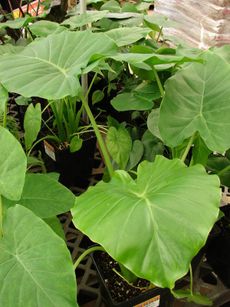Seed Pods On Elephant Ear Plants: Do Alocasia Elephant Ears Have Seeds


Do Alocasia elephant ears have seeds? They do reproduce through seed but it takes years before you will get the big beautiful leaves. Older plants in good conditions will produce a spathe and spadix that will eventually produce seed pods. Elephant ear flower seeds are only viable a short time, so if you want to plant them, harvest the pods and use them as soon as possible.
Do Alocasia Elephant Ears Have Seeds?
Alocasia odora is also known as elephant ear plant because of its colossally huge leaves and the general shape of the foliage. They are members of the Aroid family, which encompasses plants with some of the most attractive foliage available to gardeners. The glossy, heavily veined leaves are a standout and the main attraction, but occasionally you get lucky and the plant will bloom, producing unique dangling seed pods on elephant ear plant. Elephant ear flower seeds are contained in a hard shelled pod. It takes months for the orange seeds to mature, during which time the pods hang from the plant. They are a rare sight in most gardens, but in warm climates, established plants may develop a spathe and spadix, which house the male and female flowers. Once pollinated, they develop into fruits filled with many little seeds. The seed pods on an elephant ear plant must be cracked open to reveal the numerous seeds.
Planting Elephant Ear Flower Seeds
Once the Alocasia elephant ear has seed pods, remove them when the pod has dried and the seeds are mature. Germination is capricious and variable on these plants. Seeds should be removed from the pods and rinsed. Use a humic rich medium with a generous amount of peat. Sow the seeds on the surface of the soil and then lightly dust them with a pinch of medium. Spray the top of the soil with a misting bottle and keep the medium lightly damp but not soggy. Once seedlings appear, which may be as long as 90 days after planting, move the tray to a location with indirect but bright light.
Propagation of Elephant Ear
Alocasia rarely produces a flower and subsequent seed pod. Their erratic germination means that even if your elephant ear has seed pods, you are better off starting plants from offsets. The plants send out side shoots at the base of the plant which work well for vegetative production. Simply cut off the side growth and pot them up to establish and grow larger. Once the plant is a year old, transplant to an appropriate area of the garden and enjoy. They can also be grown in containers or indoors. Don't forget to bring the bulbs or plants indoors in any region where freezing temperatures are expected, as Alocasia plants are not at all winter hardy. Lift in-ground plants and clean off dirt, then store them in a box or paper bag until spring.
Gardening tips, videos, info and more delivered right to your inbox!
Sign up for the Gardening Know How newsletter today and receive a free download of our most popular eBook "How to Grow Delicious Tomatoes."

Bonnie Grant is a professional landscaper with a Certification in Urban Gardening. She has been gardening and writing for 15 years. A former professional chef, she has a passion for edible landscaping.
-
 How To Get Rid Of Mosquitoes In The Garden: 9 Natural Ways To Make Them Buzz Off!
How To Get Rid Of Mosquitoes In The Garden: 9 Natural Ways To Make Them Buzz Off!How to get rid of mosquitoes is on the minds of people in the summer in almost every region of the world. Learn how to repel the pests without toxic chemicals.
By Mary Ellen Ellis
-
 Monkey Orchid Care: How To Grow This Fascinating Species
Monkey Orchid Care: How To Grow This Fascinating SpeciesThe monkey orchid bears a remarkable resemblance to its namesake and, with a little know-how, can be successfully grown as a houseplant.
By Bonnie L. Grant
-
 How To Propagate Alocasia – Tips On Alocasia Plant Propagation
How To Propagate Alocasia – Tips On Alocasia Plant PropagationAlocasia can grow to impressive size. How do you go about propagating alocasia plants? Learn more about alocasia propagation methods and how to propagate alocasia in this article. Click here to get more information.
By Liz Baessler
-
 Feeding Alocasias: Tips On Fertilizing Alocasia Plants
Feeding Alocasias: Tips On Fertilizing Alocasia PlantsRegardless of how you grow them, fertilizing alocasia plants is essential to their healthy growth. You can learn about alocasia plant feeding and when to fertilize alocasia in the article that follows. Simply click here for more information.
By Liz Baessler
-
 African Mask Plant Care Guide
African Mask Plant Care GuideThe exotic African mask plant, also called Alocasia amazonica, loves a moist tropical environment whether it’s outside or in a pot indoors.
By Mary Ellen Ellis